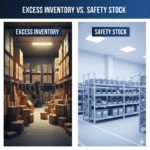When your warehouse is filled with excess inventory, every box represents tied-up capital and missed opportunities. Deciding how to offload this surplus stock is a critical business decision. The two most common paths are liquidation and wholesale, but they serve different purposes and yield different results. Understanding the liquidation vs. wholesale debate is key to choosing the right strategy for your business.
This guide will break down the fundamental differences between these two inventory solutions. We will explore the unique benefits and potential drawbacks of each, helping you determine whether quick cash flow from liquidation or the steady, brand-aligned approach of wholesale is the best option for your specific situation.
What is Inventory Liquidation?
Inventory liquidation is the process of selling surplus, overstock, or obsolete goods quickly to generate cash. The primary goal is speed and efficiency. Businesses turn to liquidation when they need to free up warehouse space, recover capital from slow-moving products, or close down a business entirely.
Liquidators purchase inventory outright in bulk, often at a significantly reduced price per unit. These buyers, like us at LiquidateProducts, have extensive networks to move these goods into secondary markets where they won’t compete directly with your primary sales channels.
Key Characteristics of Liquidation:
- Speed: The process is exceptionally fast, often concluding within days or weeks.
- Cash Flow: It provides an immediate injection of cash into your business.
- Simplicity: The transaction is typically straightforward—a single sale of a large volume of goods.
- Volume: Liquidators are equipped to handle large quantities, from a few pallets to multiple truckloads.
Liquidation is an effective tool for managing the end-of-life cycle for products, dealing with customer returns, or clearing out seasonal items after their peak. It is a strategic financial move designed to cut losses and reinvest capital more effectively.
What is Wholesale?
Wholesale involves selling goods in large quantities to other businesses (retailers) who then sell them to end consumers. Unlike liquidation, wholesale is a core part of the standard supply chain. Wholesalers typically purchase current, in-demand products with the intention of reselling them for a profit through established retail channels.
The wholesale model is built on ongoing relationships. A manufacturer or brand sells products to a wholesaler or distributor, who then stocks and supplies them to various retail stores. The pricing is lower than retail but higher than liquidation, reflecting the product’s current market value.
Key Characteristics of Wholesale:
- Brand Control: You have more say over where and how your products are sold.
- Higher Margins: The price per unit is generally higher compared to liquidation.
- Relationship-Based: It often involves long-term partnerships with distributors and retailers.
- Slower Process: Finding the right wholesale partners and finalizing deals can take time.
Wholesale is the standard business model for distributing new and active inventory. It is not typically used for obsolete or unwanted stock unless that stock is still relevant in some secondary markets.
Liquidation vs. Wholesale: A Head-to-Head Comparison
Choosing between liquidation and wholesale depends entirely on your goals, your inventory type, and your timeline. Let’s directly compare the two to clarify which path is right for you.
1. Primary Goal: Speed and Cash vs. Profit and Brand
The most significant factor in the liquidation vs. wholesale decision is your immediate priority.
- Liquidation: Choose this if your goal is immediate cash flow. If you have bills to pay, need to make room for new inventory urgently, or are managing the financial fallout of a canceled order, liquidation provides the fastest route to converting stock into cash.
- Wholesale: This is the better option if your priority is maximizing profit per unit and maintaining brand integrity. Wholesale channels move products at a higher price point and are part of a planned distribution strategy for current inventory.
2. Inventory Type: Obsolete vs. In-Demand
The condition and market relevance of your products will heavily influence your choice.
- Liquidation: This is the ideal solution for problem inventory. This includes overstock, discontinued items, customer returns, products with outdated packaging, and seasonal goods past their prime. These products have limited appeal in primary retail channels.
- Wholesale: This channel is designed for new, in-season, and relevant products. Retailers who buy wholesale want inventory they can sell easily to their customer base at a standard retail markup. Selling obsolete goods via wholesale is difficult, if not impossible.
3. Transaction Speed: Days vs. Months
Your timeline is another critical consideration.
- Liquidation: The sales cycle is extremely short. From initial contact and inventory assessment to offer and payment, the entire process can be completed in a matter of days. At LiquidateProducts.com, we specialize in making this process as fast and frictionless as possible.
- Wholesale: Building wholesale relationships takes time. You need to identify potential buyers, negotiate terms, set up distribution logistics, and manage ongoing orders. It’s a long-term strategy, not a quick fix.
4. Pricing and Returns: Recovering Capital vs. Earning Profit
The financial outcomes of liquidation and wholesale are fundamentally different.
- Liquidation: The price you receive will be a fraction of the original retail value. The focus is not on profit but on recovering a portion of your initial investment. It helps mitigate a total loss and turns a non-performing asset into working capital.
- Wholesale: Pricing is structured to allow for profit margins for both you and the retailer. While lower than direct-to-consumer prices, wholesale pricing is significantly higher than what you would receive in a liquidation deal.
Scenarios: When to Choose Liquidation or Wholesale
To put the liquidation vs. wholesale debate into a real-world context, here are some common business scenarios and the recommended approach.
Choose Liquidation If:
- You Have Aging Inventory: Your products have been sitting in the warehouse for over a year, and storage fees are piling up.
- You Need Immediate Cash: A sudden financial need requires you to free up capital quickly.
- You Are Discontinuing a Product Line: You need to clear out all remaining stock of an old model to make way for a new one.
- You Have Excessive Customer Returns: You have a large volume of returned or refurbished goods that cannot be sold as new.
- A Large Order Was Canceled: A major client backed out, leaving you with a massive amount of surplus product you weren’t prepared for.
Choose Wholesale If:
- You Are Launching a New Product: You want to get your new product into various retail stores across the country.
- You Want to Expand Your Market Reach: You are looking for distributors to help you enter new geographic markets.
- You Have a Consistent Supply of In-Demand Products: Your business model is based on manufacturing and distributing goods through a retail supply chain.
- Your Brand Image is a Top Priority: You need to maintain strict control over how and where your products are sold.
The Strategic Advantage of Partnering with an Expert
Whether you choose liquidation or wholesale, working with a knowledgeable partner is crucial. An expert can help you navigate the complexities of each market and ensure you get the best possible outcome.
As one of the leading inventory liquidation companies, we provide a streamlined, professional, and profitable way to manage surplus stock. We understand the importance of brand protection and work with you to place your goods in appropriate secondary channels, away from your primary markets. Our process is transparent, fast, and designed to put cash back into your business with minimal effort on your part.
While wholesale is an excellent channel for current goods, liquidation is the superior financial tool for dealing with excess and obsolete inventory. Don’t let leftover stock drain your resources. Embrace a smart liquidation strategy to strengthen your balance sheet and fuel future growth.
Turn Your Overstock into Opportunity
Ready to explore how liquidation can benefit your business? The debate of liquidation vs. wholesale is settled when you have problem inventory. Let us show you how easy it can be to convert those surplus goods into valuable working capital.







